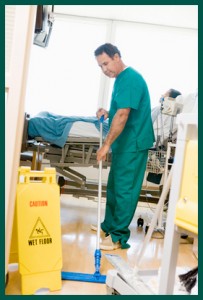Heard about an interesting paper today (sadly not open access) describing airflow simulations in an aerosol chamber. Basically they showed that if you release bugs from a mannequin, they spread all over the room… up to 3.5 meters away. A worthwhile study, but not something that wasn’t known already. What made this get so much press is that the authors used Staphyloccus aureus, the same bug that when resistant to certain antibiotics we know as MRSA.
Enter the headlines “Fears of risk of air transmission of superbugs” and “Airborne superbugs elude hospital cleaning regimes”. A bit over the top in my opinion.

I have access to the journal, but the paper is not on line, as far as I can tell. It is in accepted articles and still needs to be formatted.
I want to see if the organism they modeled included its moisture content and the effects of moisture on its aerodynamic mass, an extremely important factor for its behavior in air. Different micro-organisms has different moisture-related characteristics that determine their survival and pathogenicity/virulence. See the paper by Yang et al just posted in our Mendeley collection and in the previous blog post — “Answer to the seasonal flu mystery….” It shows the importance of the interactions between the organism’s surface or coating and the RH of the environment into which the virus is released. While the current paper is about bacteria, it is a model based on a presumably representative bacterial species. I am anxious to see the paper to read more of the details of what they did.
These characteristics of a microbial particle are important for the aerodynamics including the distance it will travel before falling to the floor — supposedly the big story here. In fact, some research in TB hospitals has failed to show much in the way of long range transport of TB from isolation wards to other wards as a source of infection.
The link articles say it was “associated with MRSA” — not that it was MRSA — that they modeled. That kind of scare-mongering is unfortunate, as David’s post indicates — “over the top.”
Note also that the ventilation system characteristics beyond air changes per hour of outdoor air will be very important in the distribution and ultimate deposition sites. Total air changes and outdoor air changes are both important and need to be examined. Air flow patterns are extremely imporant, so it will be good to be able to see the whole article to know what their modeling assumptions were.
Also note that if a diagnosed case of MRSA is in hospitalized, it would be unwise and less likely that hospital personnel with any other available options, would have another patient in the same room.
Received notice today from the NC State group, see below.
Janet
Howdy!
The time has come to start shipping out Wild Life of Our Homes sampling kits! At some point in the last year, you signed up to participate in our project studying the microbes that live on common surfaces in your home. We’re now ready to roll things out!
Â
Please complete this short form to confirm your interest, and more importantly, your address. We know some folks have moved or are simply no longer interested, and we don’t want to waste supplies. We also have a few questions for you to answer about the wild life living in and around your home – it’ll take just a couple minutes to complete and will give us a better sense of your wild life.
Â
Please respond NO LATER than Monday, November 5. We’ve kept you waiting long enough and would like to get these kits out the door ASAP! If you do not complete the form, you will not receive a home sampling kit.
Our team is continuing to work on some nifty online tools for you to see and interact with the results that come back on your home microbes. Here’s a little taste of what you’ll see.
Â
And hey, have you checked out our website lately? You’ll find info about all of our projects and a blog packed with stories about the species, big and small, with whom we share our daily lives.
Â
Thanks! We look forward to hearing from you!
Â
Holly & the Your Wild Life Team
127 David Clark Labs, Campus Box 7617 Department of Biology, NC State University
Raleigh, NC 27695-7617 US
http://www.yourwildlife.org/